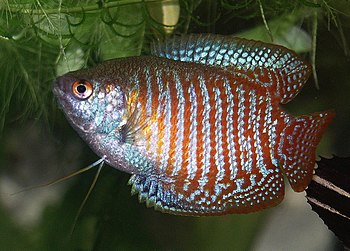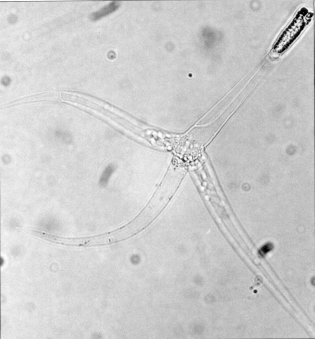 |
| Gourami (Photo credit: Wikipedia) |
Over forty years ago I first kept and bred Dwarf Gouramis. At that time they could reasonably be described as a hardy fish. Unfortunately the ones we get nowadays have lost much of this hardiness. This loss of hardiness seems to have been caused by several different things.
They have been selectively bred, producing a number of different colour variations. It is likely that many of these are inbred, and suffer from the lack of vigour frequently caused by inbreeding.
Most of the Dwarf Gouramis bred in places like Singapore will have been kept in controlled conditions and individuals which would have died out quickly in the wild will have survived and often been used for breeding. Related to this is that in captivity fast growth would have been selected for, and particularly fast growth under the near forcing diets fed to commercially bred fish. The fast-growing fish are often not as hardy as wild ones.
Disease
Related to the lack of hardiness in many commercially bred Dwarf gouramis is the fact that many of them are diseased. They are susceptible to normal aquarium fish diseases, but one is of particular concern. This is the Dwarf Gourami Iridovirus.
This disease kills the Dwarf Gouramis slowly, sometimes taking as long as a year to kill them. The symptoms include wasting of the fish and there is little doubt that before this disease was identified, fish tuberculosis was blamed for some of the deaths from this virus. This virus may have become a problem because of the extensive inbreeding of this fish in Singapore.
Many virus diseases are specific to a single species, and it is frequently reported that only Dwarf Gouramis can get the Dwarf Gourami Iridovirus. However, there are also many conflicting reports.
One study by a team led by Professor Richard Whittington of the University of Sydney, Australia found a 99.95% genetic similarity between the Dwarf Gourami Iridovirus and a virus outbreak in 2003 that killed farmed Murray Cod, Maccullochella peelii peelii. A test showed that Murray Cod can be infected with the Dwarf Gourami Iridovirus, and had 90% mortality.
There is fear that the Mosquitofish (Gambusia species) can act as a carrier for this virus and aid its spread through wild fish populations. This virus has also been reported as affecting swordtails.
One of the problems with these reports is that there are many types of fish Iridoviruses. Some of them will kill or make the fish ill while others seem to have no bad effects on the fish. To really find out what is happening would take a major research effort.
Several internet articles say that 22% of Dwarf Gouramis coming out of Singapore have this virus. This figure is actually based on a study of Dwarf Gouramis in Australian retail aquarium shops. The study found that 22% of these fish were infected with this virus. All the tested fish had been imported from Singapore. The fairly reasonable jump was made to state that 22% of the Dwarf Gouramis coming out of Singapore were infected.
Of course, all the tested fish would have been through quarantine and any fish showing signs of the disease would have been destroyed. If any batch of fish had a lot of diseased specimens the whole batch would have been destroyed. If an importer loses a whole batch of fish he has lost a lot of money and would look for another supplier.
At least one normally reputable internet site says that most of the fish coming out of Singapore are infected is a very worrying figure, but it certainly is not "most".
Government Action Needed Now!
The trade-in ornamental fish is a major part of Singapore's trade. If there is a problem this serious with Singapore's fish, it needs to be fixed.
Some years ago, a large ornamental fish farm in Australia had a serious problem with fish disease. With government help, they systematically eradicated the disease. This fish farm now has an extremely good reputation for the quality of their fish. Unfortunately, they do not breed Dwarf Gouramis.
The government of Singapore needs to recognise that there is a serious problem and to solve it before Singapore's export trade in fish is ruined.
|


